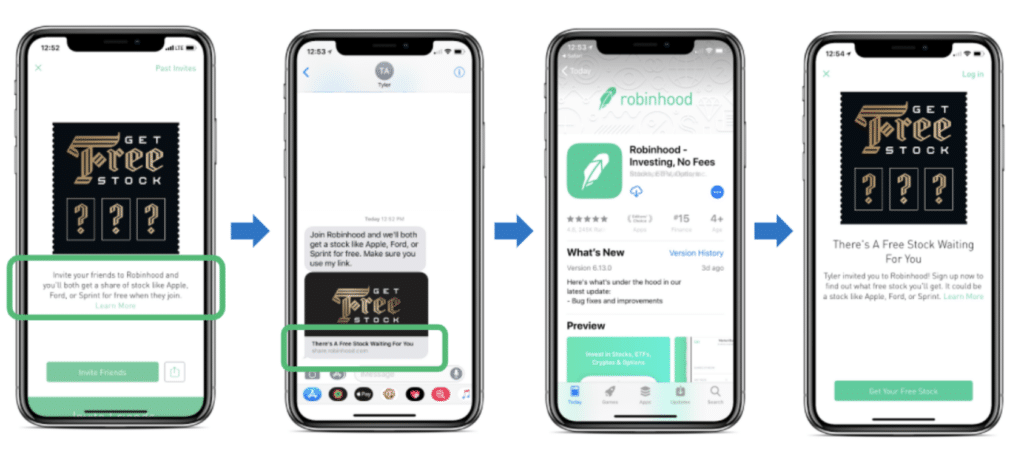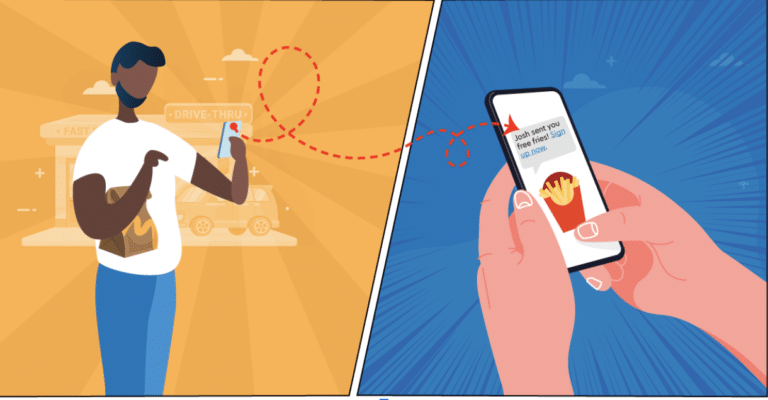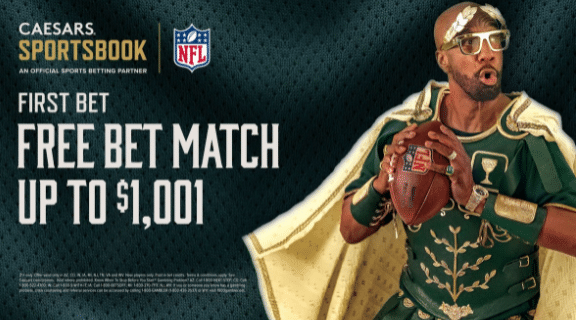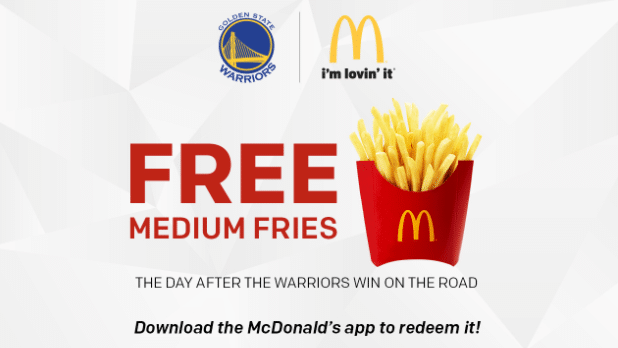Rewarding users for engagement has existed long before the mobile era in the form of discount codes, time-sensitive sales, and even physical coupons. However, the rise of mobile phones and the popularity of social sharing have created an opportunity for brands to leverage customers and prospects in a unique way: an app referral program.
In this blog, part one of a three-part series, we’ll examine the potential use cases of an app referral program and why it might be worth investing in one. In the following blogs, we will look at setting up a referral program and the advantages of an advanced referral program.
What Is a Referral Program?
Generally, a referral program rewards users for behavior that typically involves them influencing other users (“referrals”) to take advantage of a specific product or feature. The referral is usually by text or email, and the “referrer” generally receives a reward for doing it. Robinhood, for example, offers a free share of stock to a referring user and to their referral when they place their first order.

Referral programs cover many different use cases including:
A friend-to-friend (i.e. one-to-one) referral program that allows you to earn a bonus when a referred user downloads the app. Venmo is another classic example; they offer $5 to both referring users and their friends once they join Venmo.
An influencer-driven (i.e. one-to-many) referral program where users may or may not personally know each other. You may have seen the Caesar’s Sportsbook commercials where they have a celebrity promoting a $1001 match bonus when a user signs up in the app.
Brand-driven campaigns offer an exclusive bonus for downloading and using the app. For example, McDonald’s has partnered with the Golden State Warriors to offer a free side of fries when the team wins on the road and a user downloads the app to order.
Referral programs present a near endless set of configurations depending on your product, use cases, and goals. Regardless of the setup you choose, a referral program is designed to allow you to incentivize your own users to help you drive app adoption, engagement, and revenue growth.
Why Create a Referral Program?
A referral program presents a unique opportunity to efficiently monetize existing users, promote acquisition, drive re-engagement, and organically generate social proof. When deployed successfully, these programs help to align your users’ motivations with your business incentives while providing valuable insights.
Referral programs are an effective way of incentivizing users to both refer other users to install your app and then immediately promote additional installs, thus introducing the concept of an install multiplier. As this effect plays out across your user base, an effective referrals program can accelerate adoption and usage. It also has the added benefit of helping to keep those acquired users engaged and active on your platform.
While a referral program can drive adoption and increase user engagement, it also offers advantages over alternative acquisition techniques. A backend tool powering referrals will also provide actionable analytics and insights that will help development and marketing teams effectively optimize resources to drive success of the program.
There are three main categories of insights a proper attribution tool can provide:
- Basic install and reengagement measurement (e.g., “How much of X did this referral program drive?”)
- K-factor analysis (e.g. “Which of my users are the most influential and where was I able to acquire those users?”)
- Demographic trends (e.g. “Who are the people referring others and who are the people accepting referrals?”)
You may want to consider a referral program if you are rolling out a new product category, a new app feature or you want to kick start a virtuous install cycle (think: network effect) without relying on ad spend, which is becoming harder and harder to accurately attribute and measure.
Where does Branch fit in?
Only a tool that accurately captures referrals can offer value for measuring insights. A mobile linking platform like Branch, which provides seamless deep linking and powerful attribution measurement, is key to the process of referral credit assignment.
A mobile linking platform provides the accurate link matching necessary to drive a successful referral program; this matching is what allows your app to credit the correct referring user. Branch’s mobile linking platform specializes in linking beyond just traditional paid ads channels, giving it a performance advantage for owned and organic features like referrals. Accurate matching is also key to a successful user experience. The modern mobile user expects mobile links to take them directly into apps, preserving the context from their initial link click, just like on desktop web.
The debate about the best attribution model for mobile marketing is a topic outside the scope of this blog series. However, for referral programs, last touch is the most accurate, reliable, and accessible metric for gauging the impact of your referral program. Last-touch attribution ensures that you do not overwrite referral credits with some non-referred event, such as a paid ad engagement. This is where Branch’s attribution engine comes into play: our attribution platform can delineate the source of an install from the source of a post-install engagement, and then provide reporting on both, delivering powerful data and insights to help drive the success of your referral program.
We will dive into the setup and configuration of a referral program in our next edition of this blog series. Hopefully for now, we have you thinking about the potential benefits of your own referral program!
Branch provides the industry’s leading mobile linking and measurement platforms, offering solutions that unify user experience and attribution across devices and channels. Branch has been selected by over 100,000 apps since 2014 including Adobe, BuzzFeed, Yelp, and many more, improving experiences for more than 3 billion monthly users across the globe. Learn more about Branch or contact sales today.




